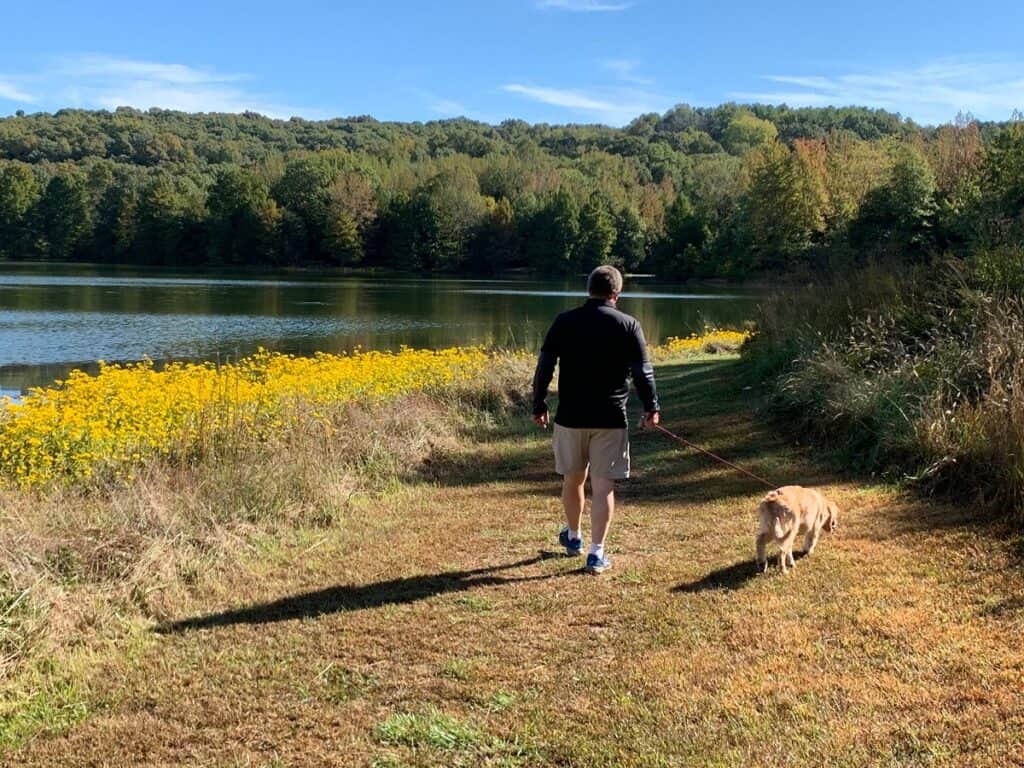Whether you are a seasoned hiker or just starting, as soon as you throw a puppy into the mix, things get a little more, well, interesting! Hiking with a puppy is an amazing adventure. It is a great way to develop that unbreakable bond we all want with our furry friends.
But before your puppy experiences the fun and excitement of hiking through the great outdoors, your hike will require extra preparation to avoid any potential dangers.
Luckily, we’ve put together this helpful list of 31 essential tips for hiking with a puppy so that you can make your first hike as safe and pleasurable as possible.
Don’t Push Your Puppy Too Hard
When you go hiking with a puppy, it’s important not to push them too hard – remember, they’re still learning their limits, and so are you. Push your puppy too hard, and they could wind up getting injured or develop a long-term health condition from overexertion.
Look at your adventure of hiking with your puppy as training for both of you on managing long hikes when they are adult dogs. Start with short walks and slowly work up to longer distances.
Also, remember that your puppy wants to please you more than anything, so it might try more physical exercise than its little body can handle. As the dog owner, it’s your job to make sure you don’t make your hike more strenuous activity than appropriate for the puppy’s age.

Growth Plate Injuries
During the first year of your pup’s life, their bones grow much faster than an adult dog, and their joints are still developing. This means they’re at a higher risk for growth plate injuries, especially on more intensive hikes.
Injuries to your puppy’s growth plates, if not healed, can cause them severe pain in their older years, often leading to osteoarthritis.
Growth plate injuries are easily avoidable; don’t push too much exercise on your puppy while still very young. If your puppy does exhibit a limp or leg pain, see your vet for treatment advice.
Muscle Development
Puppies may be furry bundles of intense energy. Still, that level of energy can come in short bursts. Don’t be surprised if they suddenly get tuckered out.
Young puppies need to develop their strength and stamina to take on a lengthy hike. Regular short hikes are a great way to start. This will also help develop their leg muscles, which will reduce the risk of injuries on longer hikes as they get older.
Fun ways to build up your puppy’s muscles and resilience before you go hiking include:
- Tug of war
- Games of fetch
- Swimming
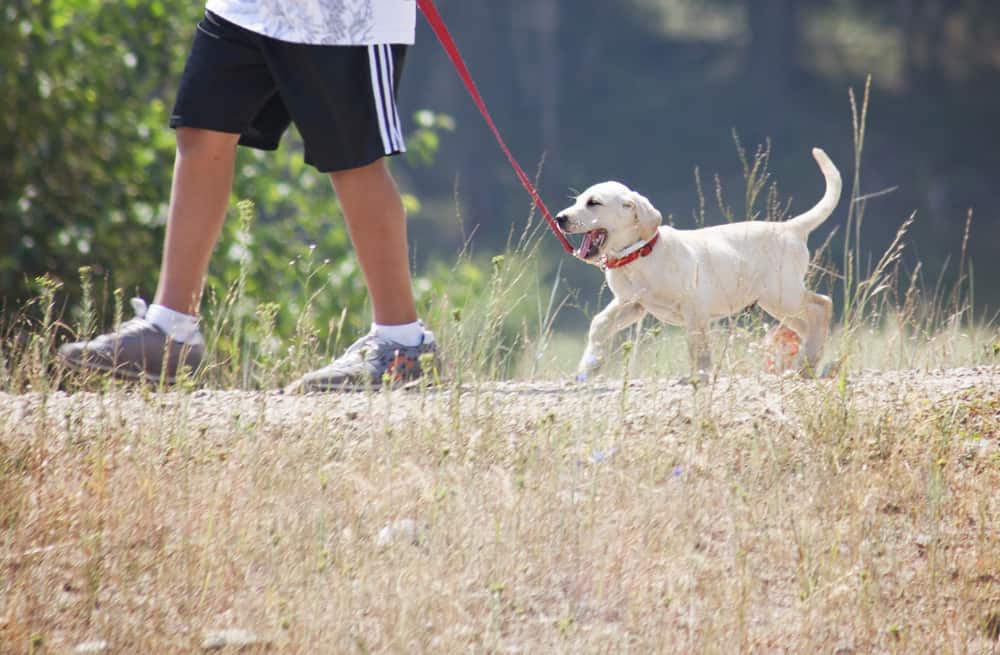
Tips for Hiking with a Puppy
You just can’t beat having a waggy-tailed hiking buddy to share your adventures with. There’s nothing like it! However, before you strap on that harness and head out on the trail, you need to plan ahead to ensure a memorable but safe hiking experience.
Let’s look at some of the things you can do to prepare your puppy.
Training Before You Go and On the Trail
There are a few basic obedience training skills that you should nail down before hiking with dogs of any age. Knowing and responding to these commands will be essential in keeping you both safe when on your adventures.
1. Recall
One of the most important aspects of training to work on before hiking is your pup’s recall. This is when you call, and your dog comes running back to you – no matter what they’re doing or where they are.
Make sure you are able to call your pup back from a short distance first. You can gradually increase the distance as they get better at coming when you call.
It’s also a good idea to practice recall in as many different environments as possible. Start training in your backyard, then expand to bigger areas like the park. Mix in other people and animals when you train. Your puppy will learn to return to you no matter what distractions are around them.
2. Leave It
Another key command that your puppy needs to recognize before you go hiking is “leave it.” This is when you tell your pup to leave something alone, whether the food on the ground, another animal, or something else they’re curious about.
This basic command is a critical need to know for hiking because there are dozens of potential hazards along the trail. Eating poisonous plants or engaging with wildlife could result in injury.
3. Leash Walking
Hiking training begins with teaching your puppy to walk on a leash. Many dog owners with a fenced-in yard wait too long to train leash walking. It’s best to start using a leash at a young age so that when you are ready for your first hike, your dog is not confused by that new leash.
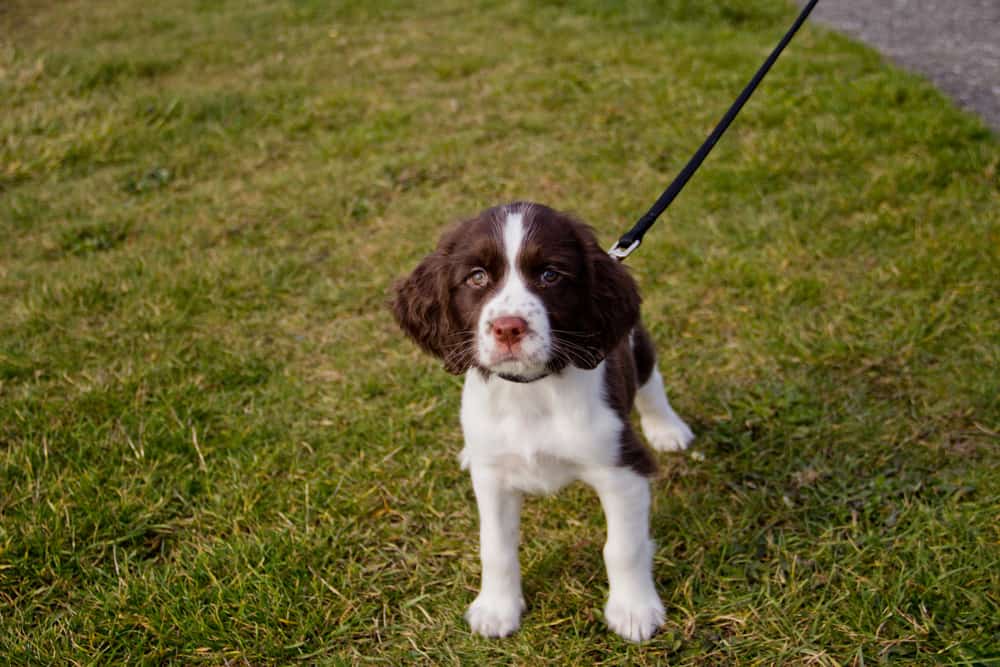
Get Moving with Your Puppy
Let’s kick off with some short micro hikes that aren’t too tiring to get your pup used to hiking and begin building up their stamina. As they get older and have more energy reserves, you can tackle longer trails with steeper inclines.
Larger dog breeds mature slower than smaller breeds, so if your dog is a larger breed, it’s best to wait until they’re at least 18 months old before taking them on the more demanding hikes.
4. Your Pace
Don’t push your puppy’s pace too hard. They only have little legs, after all. You might be used to hiking at a certain pace and distance, but your pup is still learning the ropes and needs time to adjust. Remember to keep an eye on their energy levels. Take frequent rest stops to give them a chance to catch their breath.
If your puppy is struggling, lagging, or just seems tired, be prepared to carry her part of the way.
With patience early on, your puppy will look forward to hiking for longer periods.
5. Leash vs. Harness
A significant factor you need to decide before you go is whether your pup will use a leash or a harness. A leash is the most common way to tether dogs to their human hiking partners. It also gives you control over your dog and where they go.
The downside of using a leash is that if your pup suddenly bolts after something, the sudden jolt could hurt their neck. If you choose to use a leash, make sure it’s comfortable, adjustable, and not too long. You don’t want it so long that your puppy could wrap it around themselves or get tangled up in bushes.
A harness is a wonderful alternative for hiking because they evenly distribute the weight and pull, making it more comfortable for your puppy. There are many different types of harnesses available on the market, so make sure you find one that’s snug, adjustable, and secure.
Charlie made me cry on many walks because she just wouldn’t stop pulling. And since she was already 45 pounds at 8 months I was afraid she would hurt herself and me with her pulling. We tried a lot of training, and numerous harnesses and in the end, the game-changer was the PetSafe Easy Walker. It took about a week to get a proper adjustment and train her to use the new harness. But after that week, our walks have been a joy.
You should still try training first…but give this no-pull harness a try if you aren’t making progress.
6. Try Runner’s Leash
If you choose to use a leash, there are a few various options to choose from.
A regular leash attached to your pup’s collar is the most common, but it can be uncomfortable if you walk or run for a long time. An alternative is a runner’s leash, which attaches around your waist and gives your hands more freedom.
7. Choose the Right Hiking Trail
Pick a puppy-friendly trail when planning a hiking trip with your furry friend. Stay clear of trails that are too steep or rugged for your pup’s little legs. Trails that are brief and not too challenging are a perfect place to start. They will be gentler on your dog’s muscles and joints while they are still growing.
Even if you are an expert in the more challenging routes, your young puppy needs time to build up to the more advanced trails. Have some patience. In a matter of months, you’ll have your furry friend beside you on all your hiking adventures.
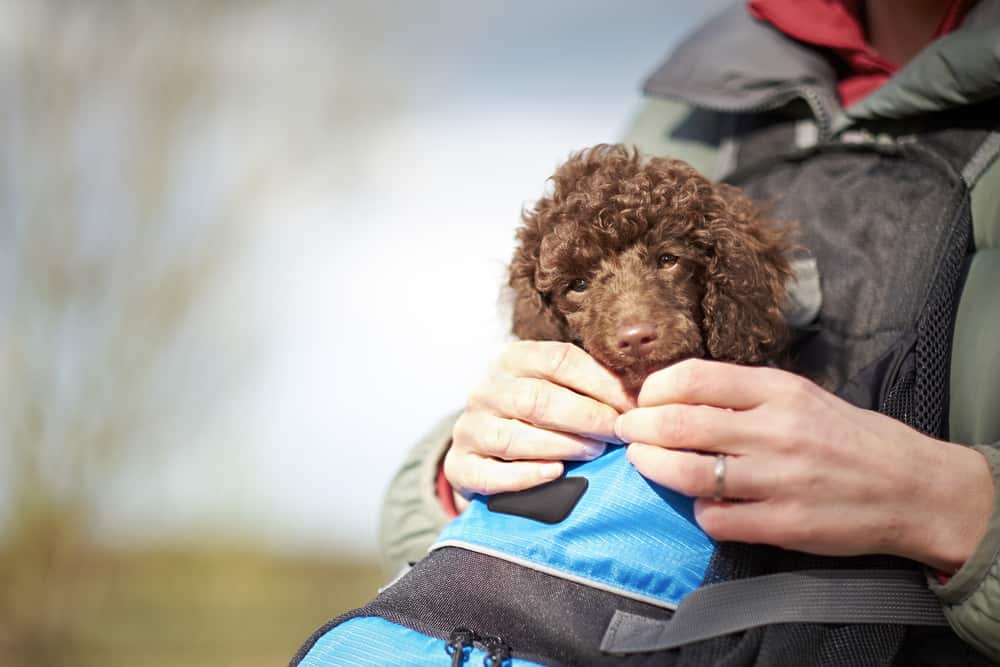
8. Be Prepared to Carry Your Puppy
No matter the size of your puppy, there will probably come a time when they require a break or need to be carried. It’s essential to be able to carry them correctly so that they don’t get injured and you don’t strain your back.
For a short distance, you can carry a small puppy in your arms, but your back isn’t going to appreciate walking in that posture for long. Special puppy backpacks are wonderful for properly distributing the pup’s weight. Or for a small breed dog, a sling dog carrier works well.
A puppy carrier designed for hiking is a great investment for small breed puppies that you know will still need to be carried for portions of long hikes when they get older.
9. Should You Let Your Puppy Off-Leash?
Always check the rules of the hiking trail you’re planning to use to see if off-leash dogs are allowed.
If they are, you need to make sure your puppy is well-trained and has excellent recall before attempting off-leash walking in a new and strange environment. If your puppy is still working on their recall, keeping them on a leash while hiking would be safer.
You may also consider using a long line (attached to their harness or collar) to give them some extra freedom while still keeping them under your control. Always check the leash rules of the trail, as some limit leash length to six feet.
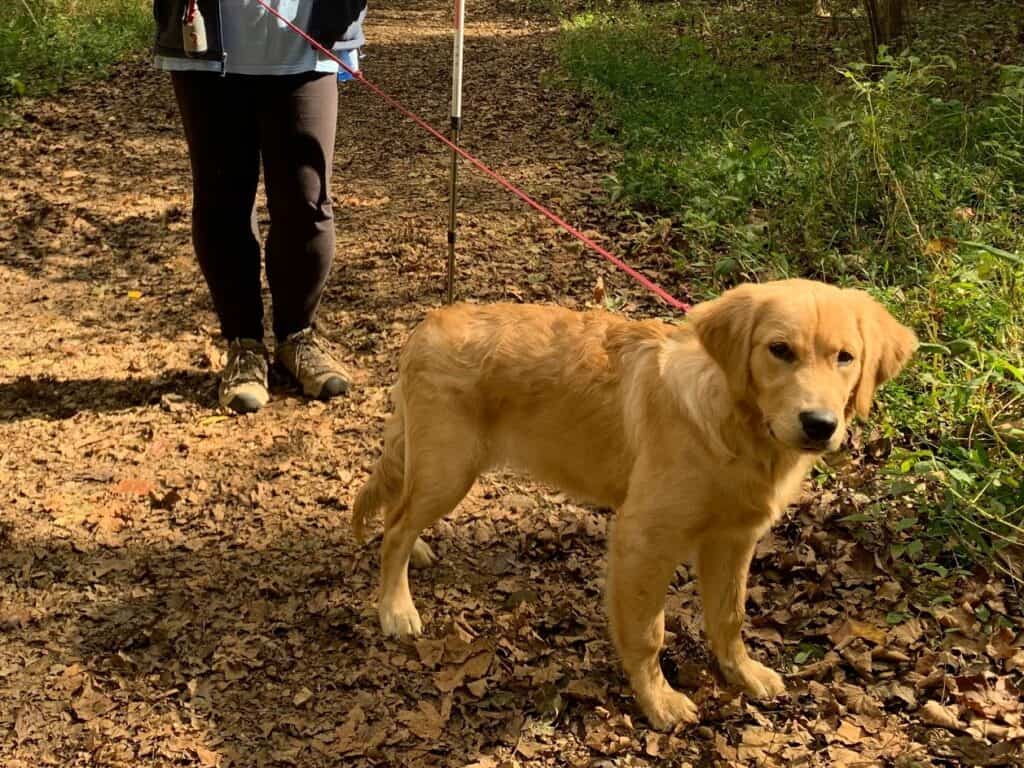
Respect the Trail
Remember, you’re sharing the hiking trail with others, and it’s important to be respectful and considerate when using it.
Keep your pup away from any areas that have “no dogs allowed” signage, hiking trails above the tree line, or where there is sensitive wildlife.
10. Respect Other Hikers
You should always maintain control of your dog when around other hikers. Don’t allow them to jump on or bother other people on the trail. Be extra mindful of hikers with small children or those who are hiking alone.
Not everyone loves your dog the way you do. Some people may even be afraid of them, so be considerate enough to give them space and keep your pup close.
11. Respect Other Dogs
If there’s another dog on the trail, trail etiquette is to always check with the dog’s owner before letting your dog approach them. Once you have permission, make sure to keep both dogs on a leash to slowly get acquainted with each other.
Be cautious no matter what the other dog owner tells you about their dog’s obedience skills. When Charlie was 5 months old, we encountered a dog whose human told us it was a service dog that she was exercising for the owner. Maybe… but the trainer had no control. Charlie and I were a little freaked by the high-energy dog. We had different expectations for a service dog’s behavior.
12. Protect the Ecosystem
Dogs love to dig, but digging on a hiking trail can damage the vegetation and disrupt the natural ecosystem. If your pup begins digging, quickly stop them and fill in any holes they’ve made.
The same goes for trampling flowers or hiking through fragile plant life. Try to stick to the trail and avoid damaging the flora where possible.
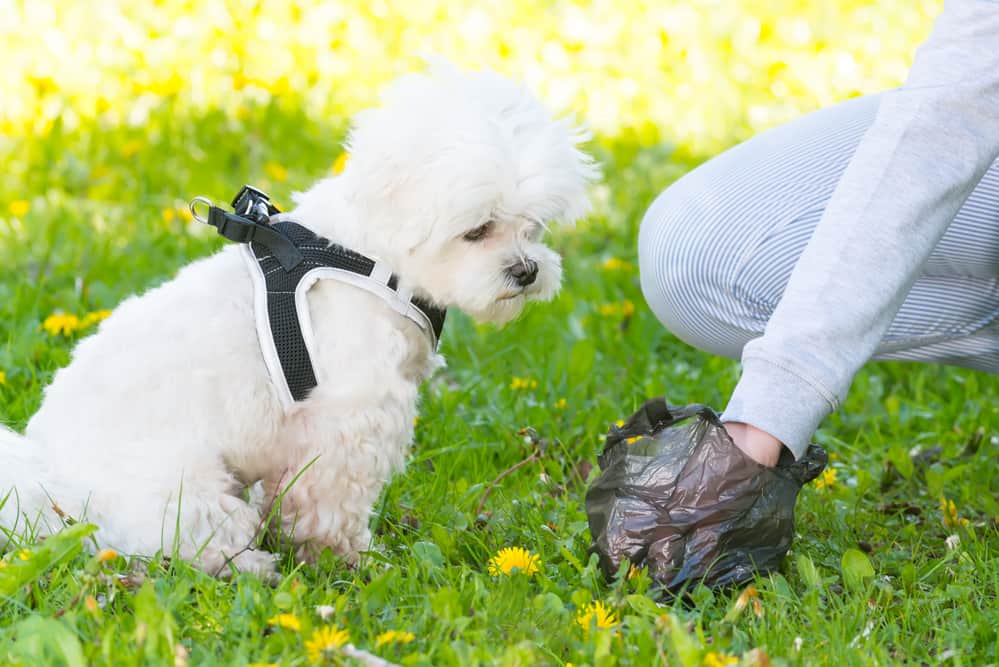
13. Pack Up Your Poo
No one likes to tread in a pile of stinky dog poop, so make sure to carry poop bags and pick up after your pup and pack out their waste. It’s just plain rude to leave a smelly mess for other unsuspecting hikers to step in.
Additionally, the smell of feces will attract other wildlife to the trail. Artificially changing the behavior of wildlife is not healthy for those other critters.
And did you know that dog poo can take a year to decompose? That’s because they eat a high protein diet. Most critters in the woods are eating a primarily plant diet and their poo rots quickly.
14. Bring Plenty of Water and Food
Like us, dogs need plenty of water and food to fuel their hiking adventures. Bring along more water and food than you think you’ll need for both you and your pup, and pack some high-energy snacks for them as well. We like to carry these Blue Buffalo Health Bars in a variety of flavors.
A hiking daypack is a great way to carry all your hiking essentials, including water, food, and a first-aid kit (more on that below).
Be Danger Aware
While hiking with your pup can be a lot of fun, there are also some dangers. Here are a few things to watch out for:
15. Prey Drive
Puppies are playful and inquisitive little fluffballs (that’s why we love them), which also means they see most things as a game. Depending on your pup’s breed, they may have a strong prey drive. A big fluffy rabbit or squeaky squirrel may just be too tempting.
If your puppy sees an animal, it may take off after it without thinking and could easily get lost.
Investing in a GPS tracker for your dog might be invaluable in helping you to track them down should they become separated from you.
16. Dangerous Wildlife
Depending on where you’re hiking, there may be some particularly wild wildlife around. Animals such as coyotes, snakes, and bears are all potentially dangerous to your furry best friend.
Protect your dog by keeping them close and under control at all times, especially if you see any wildlife signs posted on the trail.
17. Wildlife Mating Season
During certain times of the year, animals will be in mating season and can become more aggressive than usual. Ensure your pup is kept on a leash around this time to always remain in control should you encounter any overly hostile wildlife.
When hiking in an area containing deer during the mating season, avoid hiking during dawn and dusk, as these are the times when they are at their most active.
18. Hunting Season
Be aware of the hunting season dates when visiting an area where hunting is permitted, and avoid hiking during these times. Wearing bright clothing may help make you and your puppy more visible and less likely to be mistaken for game. A blaze orange vest like this will alert hunters to your dog’s presence. And you might find a bright vest like this helpful on all your hiking trips, no matter the season so you can quickly see your puppy.
19. Poisonous Plants and Mushrooms
In her first 3 months, our Charlie girl ate EVERYTHING! That included a buffet of mushrooms growing in the woods when she was only a month old. Luckily her worst symptoms were volcanic bowl movements and vomiting. Our vet gave her something to settle her tummy and she quickly got over it. However there are many poisonous plants and mushrooms that grow in the wild that puppies won’t survive unless treated quickly. So it’s essential to be aware of these before hiking with your puppy.
Some common poisonous plants you might see in the wild include:
- Milkweed
- Oak Acorns
- Mayapple
- Hickory Nuts
You may also come across the following poisonous mushrooms:
- Death Cap
- Destroying Angel
- Fly Agaric
If you’re unsure about a plant or fungus, it’s best to err on the side of caution and avoid letting your pup come into contact with it. If you think your dog has eaten something poisonous, seek professional medical help immediately.

20. Streams and Lakes
Water sources can be extremely dangerous for dogs, so you should take extra care when hiking near them. Puppies often love to play in shallow water. But young dogs can get tired quickly when swimming and may not be able to make it back to shore, or they could also get caught out by strong currents.
There is also the risk of them drinking water that contains harmful bacteria or toxins that can make your poor baby really sick.
Your Puppy’s Health
Make sure that your pup is up-to-date on all their vaccinations. This is especially important if you’re hiking in an area with lots of other dogs, as they can easily contract diseases from each other.
21. Food and Water
Dogs use a lot of energy when hiking, and they can get dehydrated and hungry quickly. Take a collapsable bowl, we love these little bowls because they clip right onto my backpack or onto Charlie’s leash. And pack more food and fresh water than you think you’ll need in case you get lost, or the hike takes longer than expected.
Most dogs typically need about eight ounces of water per hour of hiking. They also need at least 25 percent more kibble than usual to replace those lost calories.
22. Avoid Overheating
While you can hike in light, breathable clothing, your pup’s doing the same route in a thick fur coat. This can put your fur baby at serious risk of heatstroke. It’s vital for their safety to keep a watchful eye on them when it’s warm. Hiking in hot weather is more dangerous for your pup than it is for you… and you know how miserable you can get when it’s hot.
Try hiking during cooler weather and take breaks often in shady areas if it’s hot. If your furry friend starts to pant excessively or seems lethargic, these are clear signs they need a break and plenty of water.
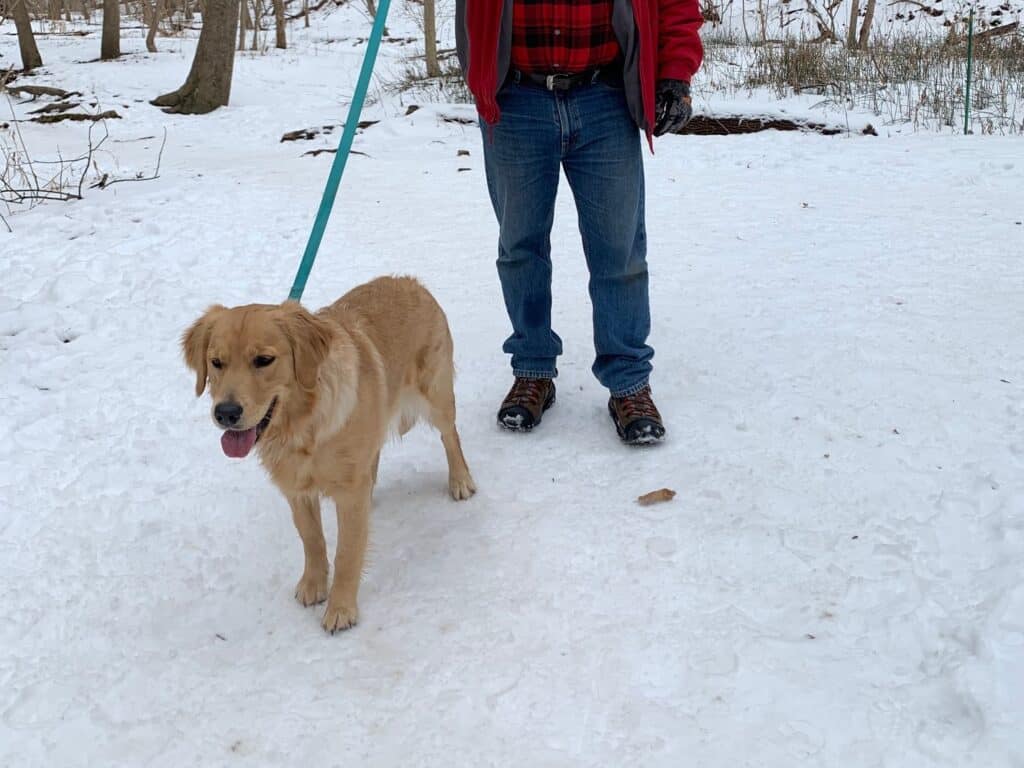
23. Monitor Your Puppy’s Body Temperature in the Cold
Winter hiking is a lot of fun for puppies who like to roll and play in the snow. But there are less obvious dangers. How long a puppy can hike in the cold varies by breed. According to the AKC, a short hair puppy might reach their limit in 10 minutes, fury pups like my golden might be good for 30 minutes and artic dog breeds might go for hours. The trick is to slowly acclimate your dog to cold weather with short hikes until you know your dog’s limits.
If hiking with your dog in winter be prepared to warm them if they get chilled. For a small pup, you could tuck them inside your jacket. For a larger puppy carry a blanket or towel so you can wrap them up.
24. Protect Your Pup’s Paws
Puppies also have delicate paw pads that can easily get injured on rocky or rough terrain. Watch your pup’s step and watch any cuts or scrapes on their paw pads. Dog’s paw pads are built to deal with everyday wear and tear, but they can still get sore or injured on a long hike. Check and clean between their paw pads for burrs so their little feet don’t get irritated.
When hiking in winter weather, it’s a good idea to put dog boots on your puppy’s paws to protect them from cold and ice. Our puppy hates booties so we use a dog paw wax, like used for sled dogs, and have been super happy with her paw health.
25. Use a Reflective or Light Up Dog Collar
Anytime we hike or walk near dusk, I slip an LED collar onto Charlie. If she happens to get off of her leash I’ll have peace of mind knowing I can see her location. And if we are near the roads, I know cars will see her too! We wrote a complete guide to the best LED Dog Collars.
26. Fleas and Ticks
Fleas and ticks can be a real headache when hiking with your dog. These pesky critters are not only a nuisance, but they can also transmit diseases to your dog.
The best way to protect your adventure buddy from fleas and ticks is to use preventative treatments. Oral medications provide protection by killing the fleas and ticks on your dog. Dosage is usually based on your dog’s body weight, but it’s best to check with your vet to ensure what you are giving your dog is best for their health.
You should always check puppies for fleas and ticks after a hike, especially if they’ve been trekking through tall grass or wandering through dense woods.
27. Carry a Puppy First Aid Kit
Even if you’ve taken all the necessary precautions, accidents can still happen. A first aid kit designed for dogs is an essential item to include in your backpack when you hit the trail. You can purchase dog first aid kits like this with all the supplies you need. Or you can create your own. Your kit should include items such as:
- Gauze
- Bandages
- Antibiotic ointment
- Hydrogen peroxide
It’s also a good idea to bring along any medications your dog is currently taking in case they need them while hiking. Also, include a copy of your dog’s medical records in case you need to go to the vet while you’re away from home.
28. Have your own Emergency Kit
In addition to your dog’s first aid kit, you should always carry your personal emergency kit. Although you may have only planned for a short hike, accidents happen and you should be prepared. You can’t help your puppy if you can’t help yourself. Unlike trained rescue dogs, your little puppy is not going to know how to get help if you get hurt. You can get our full packing guide for day hiking here.

As Your Dog Gets Older
While your dog is still young, it’s the perfect time to start training for things he will need to know for future long distances. Here are a few things to consider starting early.
29. Practice Carrying Their Own Pack
If you are an avid hiker, you’ll want your dog to learn to carry a small backpack. So while young you can start them with an empty pack so they can get used to the feel. Don’t add weight to the pack until your pup’s bones and muscles are fully developed which is 12-18 months old. And then add no more than 10% of their body weight to the pack.
30. Practice Using a Carrier with Small Dogs
As small dogs get older and more experienced hiking, you will want to take hikes of long distances. But, those little legs will still get tired faster than yours. Many dogs love to be carried in a dog pack to take breaks during long hikes. And if you start your puppy early they will be ready for hiking like a grown-up.
31. Keep it Fun
The love of hiking in older dogs starts with positive hiking experiences as puppies. If you want your best friend to jump for joy when he sees the backpack come out, it starts with making the first trips hiking with dogs as much fun as possible. Play games, play fetch with her favorite toy and don’t overdo it. Your dog is looking forward to spending time with you.
Get more tips on taking a road trip with your dogs here.
Don’t forget to Check Trail Status before you Hike
Not all hiking trails are dog-friendly. As we travel through National Parks with Charlie we check before we go which trails allow dogs. Here’s a few of our guides to dog-friendly National Parks:
Final Thoughts
Hiking with a puppy doesn’t have to be a daunting task. Preparation, common sense and a watchful eye are all you need to ensure you both have a fun and safe time on the trail.
Remember to be patient with your puppy and take breaks often to avoid over-exercise. By following these simple tips, you can hit the trails with confidence. Hiking with puppies is pure joy!
Also Check out our helpful tips for Taking Your Dog Camping for the First Time!
